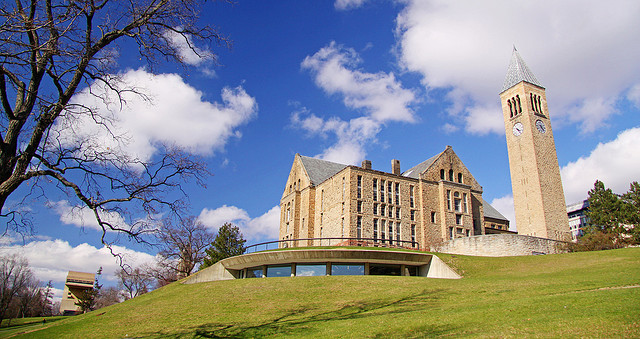- California Assembly OKs highest minimum wage in nation
- S. Korea unveils first graphic cigarette warnings
- US joins with South Korea, Japan in bid to deter North Korea
- LPGA golfer Chun In-gee finally back in action
- S. Korea won’t be top seed in final World Cup qualification round
- US men’s soccer misses 2nd straight Olympics
- US back on track in qualifying with 4-0 win over Guatemala
- High-intensity workout injuries spawn cottage industry
- CDC expands range of Zika mosquitoes into parts of Northeast
- Who knew? ‘The Walking Dead’ is helping families connect
[NR] What Ivy League affirmative action really looks like from the inside
A view of Uris Library and the John McGraw clock tower from Cornell University’s Libe Slope. (Courtesy of Matt Hintsa via Flickr/Creative Commons)
Asian Americans have finally had enough. They’re tired of working harder, achieving more academically, then having that held against them as they try to fulfill their educational dreams in our nation’s most elite universities. To gain entry into top private schools such as Harvard or the best public schools such as the University of North Carolina–Chapel Hill, no one has to do better than Americans of Chinese or Japanese or Korean descent. To make room for black, Latino, and — yes — white students, deserving Asian Americans are pushed aside. And they’re tired of it.
So last week a coalition of more than 60 Asian-American groups filed complaints with the Department of Justice and Department of Education, alleging systematic racial discrimination in college admissions. They’re right, of course. Colleges do systematically disadvantage Asian students, and the problem is worse than they imagine. I’ve seen it with my own eyes.
Years ago, before I became a full-time constitutional lawyer, I taught at Cornell Law School — an Ivy League school and one of the top law schools in the country. My second year on the faculty, I served on the admissions committee, and I saw firsthand how not just race but ideology distorts the admissions process. Ivy League admissions are one part meritocracy — the students are quite bright — and one part ideological engineering. And if Americans broadly understood how the process works, support for affirmative action would diminish even further.

















